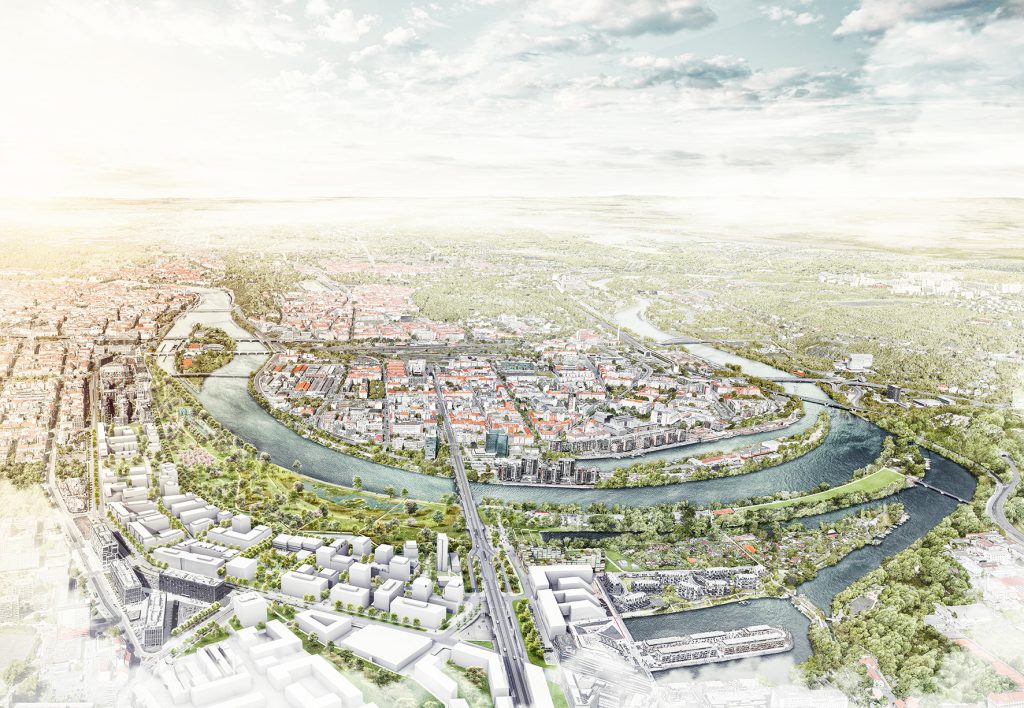COP26: Implementation at the local level is key to stay below 2°C

“Cash, coal, cars and trees” was the official mantra at the recent UN Climate Conference, the COP26, in Glasgow.
Billboard
Skyscrapper
Halfpage
“Cash, coal, cars and trees” – this was the official mantra at the recent UN Climate Conference, the COP26, in Glasgow. Between November 1 and 13, more than 35,000 delegates from all over the world gathered in the Scottish city to come up with the Glasgow Climate Pact. After much discussion and even some tears, the parties have come to an agreement. What does this mean for urban planners and architects?
The annual COP conferences are a diplomatic mega-event. At this year’s COP26 in Glasgow, logistics and grey weather were not the only challenges: Some delegates even doubted that they would be able to come to an agreement at all. This is the only global conference where the richest countries, often the largest emitters of CO2, and the poorest countries, often those who suffer the most from climate change-related weather events, sit at the same table. Countries such as Tuvalu have the moral authority, but that is not enough to create an agreement.
The Glasgow Climate Pact showed that an agreement was possible. But the goal to keep global warming well below 2 degrees, as declared in the Paris Agreement in 2015, is barely alive now.
One of the big successes of the COP26 was the commitment of countries to present annual NDCs. These Nationally Determined Contributions are self-defined goals for the mitigation of climate change effects. They will now have to be reviewed every year, which increases accountability. On other topics, COP26 provided mixed results.
Medium Rectangle
Halfpage

Cash
Funding climate change adaptation and mitigation measures was one of the COP 26’s hottest topics. In the end, countries only agreed to “continue the dialogue”. This was particularly devastating for island states and other countries with a rich flora and fauna, as the expected agreement on loss and damages was not achieved.
To slow down global warming, investments in the region of trillions of Euros are necessary. No COP will achieve this kind of commitment, which is why public-private investment could play a very important role. Experts foresee that green companies will be the winners of the climate crisis.
Coal
The last few minutes of the COP26 negotiations turned out to be the most nerve-wracking. Together, China and India managed to water down the wording from “phasing out coal” to “phasing down coal”. While this is still more than any other climate agreement has ever included on the topic of coal, it is not enough.
At the same time, it is important to remember that there is no global climate authority. Even if the COP26 negotiations had resulted in commitments to phase out coal, accountability for action at a local level is lacking. Processes such as phasing out coal typically happen bottom-up at the country or even the regional level. Also, the Glasgow Climate Pact has at least made it harder to finance coal, which in turn makes transitioning away from coal much easier.
Cars
Private vehicle as well as freight vehicles are responsible for staggering levels of CO2 emissions. However, negotiators did not manage to convince big car manufacturers to stop producing combustion engines in the next years or even decades. Many car companies were absent from the conference, showing a profound disinterest in green alternatives to petrol cars.
Trees
One of the successes of the COP26 conference was a deforestation deal, which was even signed by countries responsible for large parts of deforestation, such as Brazil. Again, this is not a binding agreement, but the commitment to halt deforestation by 2030 does show some progress.
Medium Rectangle
Halfpage

What does this mean for architects and planners?
The failure of the international community to commit to ambitious goals, funding and accountability does not mean that global warming cannot be kept below 1.5 or 2 degrees. On the contrary: When countries do not step up, it falls to the public and to private companies to do their part. Pressure from voters and consumers is one of the most efficient tools to create accountability and real change, as is the learning process between countries.
With about 75% of global CO2 emissions coming from cities and 40% coming from the construction sector, anyone who works with and for cities has a particularly important role in fighting climate change. These are some measures local policymakers, architects and planners can implement:
- Including local trees and wildflower lawns in building plans
- Working with companies to cut supply-chain-related emissions
- Focusing on less carbon-intensive materials in construction, such as timber
- Working closely with communities to enable them and turn their knowledge into action
- Creating links between stakeholders and their tools
- Ensuring the sharing of data, information, and research.
- Going beyond the minimum requirements of cutting emissions.
- Making climate and social justice part of every post-pandemic decision to “recover forward”.
Medium Rectangle
Halfpage

Make change happen
One example of climate action at the local level is Barcelona’s Superilla project. The city is gaining one million square metres of public space by repurposing former car space. There is no traffic on Fridays in central Barcelona, and the Superilla superblocks promote walkability as well as green urban space. It is a cost-efficient, scalable and bottom-up solution that will result in a much more sustainable cityscape.
In the end, the goal of keeping global warming below a certain degree threshold is not only the responsibility of diplomats meeting for events such as the COP26. It is down to cities and everyone living in and working in cities to place pressure on those in power and to make more sustainable choices. Next year’s COP will take place in Egypt. Let us remember that we don’t have to wait until the end of 2022 to make change happen.












